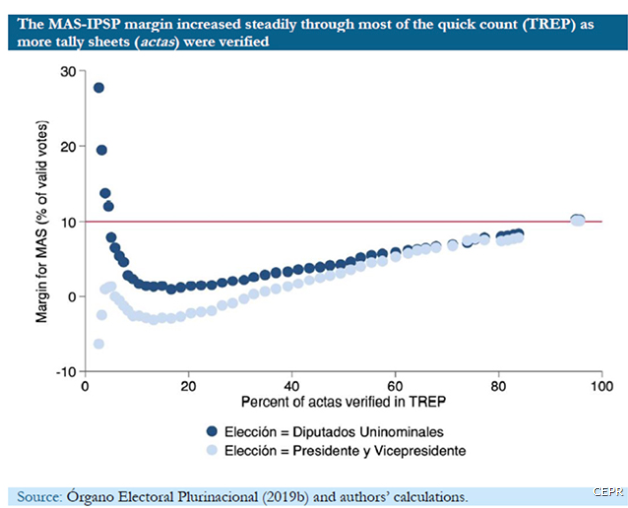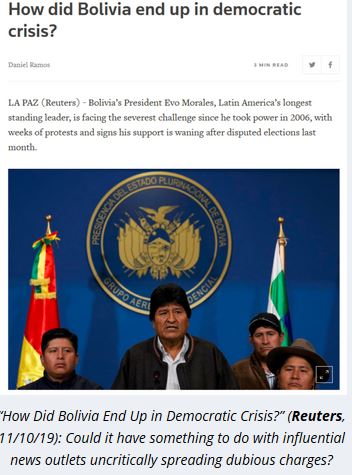|
Reuters Shields OAS Over False Claims That
Sparked Bolivia Coup
By Joe
Emersberger
December 20, 2019 "Information
Clearing House"
-
Organization of
American States (OAS) election monitors
published a “final report” on December 4—22
days later
than promised—on Bolivia’s October 20
presidential election, won by President Evo
Morales. The tardy release of the final
report contrasted sharply with the way the
OAS rushed to impugn the election
the day after
it took place.
Only three days
after the election, the OAS published a
preliminary report
that reiterated its negative assessment. On
November 10, it then issued a
press release
saying the election should be annulled. In
these statements, the OAS claimed that the
change in Morales’ lead in the last 16% of
the vote count was “drastic,” “inexplicable”
and “hard to explain.”
By November 11,
mutinous generals and police (combined with
armed opposition vigilantes) had driven
Morales into exile in Mexico. He and his
vice president
barely escaped
with their lives. Morales’ house was
ransacked.
Since then, the security forces that refused
to protect the democratically elected
government have killed some
32 people
to prop up the coup-installed dictatorship.
When the final
OAS report on the election was belatedly
released on December 4, a Reuters
article (12/4/19)
about it ran with the headline “Bolivia
Election Rigging in Favor of Morales Was
‘Overwhelming’: OAS Final Report.” The only
critic of the OAS report mentioned in the
article was Morales himself.
But the OAS had
come under heavy fire from US-based
economists and statisticians ever since it
began impugning the election on October 21.
It’s impossible to learn that fact in
114 Reuters articles
about Bolivia since the October 20 election.
None even mentions the extensive technical
criticism the OAS has received. The
criticism should have received much more
than a discrete mention in an article or
two, but in over 100 articles, the
London-based wire service didn’t even
provide that. On December 12, I sent an
email to several Reuters journalists
and editors who have produced articles on
Bolivia since October 20. I asked why that
criticism has been completely ignored. None
have replied.
On October 23,
the Center for Economic and Policy Research
(CEPR) issued a
press release
asking that the OAS retract its comments
about the election. On November 8, the think
tank published a paper
rebutting
the OAS. Mark Weisbrot, co-founder of CEPR,
followed up with an op-ed in MarketWatch
(11/19/19)
that said the OAS “lied at least three
times: in the
first press release,
the
preliminary report
and the
preliminary audit.”
On November 25,
four members of the US Congress
asked the
OAS to respond to very specific questions
raised by CEPR. On December 2, the
Guardian
published a letter
signed by 98 economists and statisticians
asking the OAS to “to retract its misleading
statements about the election, which have
contributed to the political conflict and
served as one of the most-used
‘justifications’ for the military coup.” Did
Reuters really miss all of this?
|
Are You Tired Of
The Lies And
Non-Stop Propaganda?
|
Not ‘hard to explain’
The
graph below substantiates much of CEPR’s
case against the OAS. It also exposes common
deceptions in Reuters reporting.

The light blue
dots are a plot of Evo Morales’ lead over
his nearest rival against the percentage of
the vote counted by the unofficial “quick
count.” The dark blue dots do the same for
Morales’ political party (MAS) in
legislative elections. Following OAS
recommendations,
Bolivia has a “quick count” (TREP) that
keeps the public updated, and a slower,
legally binding count (the computo).
The legally binding count was never
interrupted. The TREP stopped being
published at 84% of the count, but the
electoral authorities
never committed
to publishing it past the 80% mark.
Morales’ lead
increased steadily as votes from the more
pro-MAS areas came in. When the TREP was
stopped at 84%, his lead was 7.9 points. By
the time all the votes were counted, the
official tally had him just over 10 points
ahead. The 10-point margin was crucial
because to avoid a second round, Morales
needed at least 40% of the vote and a
10-point lead over his nearest rival.
Morales received 47% of the vote, which was
in line with what
pre-election polls
predicted.
The two-point
lead increase in the last 16% of the vote
count was not “drastic”: It was consistent
with a gradual increase in his lead
throughout the election. It was also not
“hard to explain”; CEPR’s
precinct-level analysis
of where the final votes were coming from
showed it was quite predictable.
Parroting the
OAS line, Reuters articles were
deceptive. One article (11/6/19)
stated the vote was “marred by a near
24-hour halt in the count, which, when
resumed, showed a sharp and unexplained
shift in Morales’ favor.” Others (11/4/19,
11/6/19,
11/6/19,
11/8/19,
11/8/19,
11/10/19)
used very similar language describing a
“halt” or “pause” to “the count”—thereby
obscuring that there were two counts, and
that the legally binding one was never
halted.
Another
deception in many articles was neglecting to
tell readers that Morales already had a 7.9
point lead when the quick count was stopped. For
example, one Reuters article (11/10/19)
ran with the headline “How Did Bolivia End
Up in Democratic Crisis?” It vaguely stated
that the election seemed to be “heading to a
second round” but after an (imaginary)
“pause in the count,” Morales had a
“10-point-plus lead.”
when the quick count was stopped. For
example, one Reuters article (11/10/19)
ran with the headline “How Did Bolivia End
Up in Democratic Crisis?” It vaguely stated
that the election seemed to be “heading to a
second round” but after an (imaginary)
“pause in the count,” Morales had a
“10-point-plus lead.”
Notice how it’s left to the reader to
imagine by how much Morales’ lead increased
after the quick count was stopped. And
Reuters also conveyed nothing about the
trend. See the graph above. Morales did not
have a constant 7.9 point lead for much of
the election that suddenly jumped at the
end. Nor was his lead declining when the
quick count was stopped. The lead had been
steadily increasing through almost the
entire vote count.
The trend in
the last 16% of the count was also
extremely similar
to what took place in a 2016 referendum on
term limits that Morales narrowly lost—an
election result viewed as sacrosanct by
Morales’ opponents. In that election, there
was also about a 2-point increase in the
share of the vote for Morales in the last
16% of the vote.
Ducking debate
The Mexican
government had agreed to let
Jake Johnston
of CEPR respond to the OAS final report at
the permanent council meeting on December
12. The OAS
refused to
allow it. Johnston would have presented
CEPR’s
preliminary response
to the 100-page final report. Reuters
has thus far said nothing about the OAS
ducking its main critics. Of course, to do
that, Reuters would have to break its
silence on the entire debate.
Among other
things, CEPR
observed
that the OAS final report doubled down on
its false claim of a “drastic” and
“inexplicable” change in Morales’ lead; that
the report focused on a “hidden server” and
other “vulnerabilities” in the electoral
system, but “conceals or fails to provide
information” showing that those
vulnerabilities impacted the results; that
226 tally sheets the report claimed prove
“deliberate manipulation” overwhelmingly
point to a “well-known phenomenon: In rural
areas and smaller voting centers, it is not
uncommon for one person to fill in the tally
sheet, and then have the individuals each
sign it.” The OAS final report also shifted
to claiming that manipulation occurred in
the last 5% of the count, but Morales
received a smaller share of the votes cast
in the last 5% of the count compared to the
previous 5%. Additionally, CEPR argued, his
share of the vote in the last 5% was also
“entirely predictable based on the prior
trends seen in the geographic areas from
where these final votes came.”
Incidentally,
David Rosnick, also with CEPR, very recently
refuted a
separate statistical analysis that
apologists for the coup have been
citing—mainly on social media, since in
outlets like Reuters, there is no
debate to be followed at all.
OAS’s unmentionables
The bureaucracy
of the OAS is based in Washington and is
about
60% funded
by the US government. In
114 articles,
Reuters never mentioned this either.
If the OAS were based in Caracas and 60%
funded by Venezuela, do you think that would
have been mentioned a few times? OAS
“monitoring” of elections in Haiti in 2000,
and again in 2011, was used to help
Washington disgracefully
overrule
Haitian voters. The current OAS general
secretary,
Luis Almagro,
recently blamed
Cuba and cash-strapped Venezuela for huge
protests against neoliberal policies in
US-allied states: Colombia, Chile and
Ecuador.
Morales, a
close ally of Venezuela and Cuba, was
gambling when he agreed to let the OAS
monitor the election—especially given that
the member states of the OAS have shifted
towards right-wing, pro-US governments,
giving much less of a counterweight to
Washington’s influence within the OAS
bureaucracy than in previous years. But not
allowing OAS monitors would also have been
dangerous, providing a different pretext for
Washington and compliant outlets like
Reuters to impugn the election. That
could easily have resulted in the US
imposing crippling economic sanctions—whose
impact Reuters could also be relied
on to bury (FAIR,
6/14/19).
It’s far more likely that Bolivia’s election
was clean, and that the OAS audit was dirty,
than the other way around. Unprincipled
journalism from one of the world’s major
news agencies has hidden that from a lot of
people.
Joe Emersberger is a writer based in Canada
whose work has appeared in Telesur English,
ZNet and CounterPunch.
This article was originally published by "Fair"
- -
Do you agree or disagree? Post your
comment here |